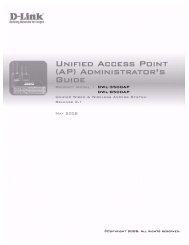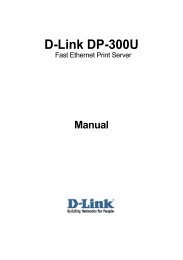Product Manual
Product Manual
Product Manual
Create successful ePaper yourself
Turn your PDF publications into a flip-book with our unique Google optimized e-Paper software.
MAC Address Aging<br />
Time<br />
DES-3526 / DES-3526DC Fast Ethernet Layer 2 Switch<br />
Minutes, 5 Minutes, 10 Minutes, 15 Minutes or Never. The default setting is 10<br />
minutes.<br />
This field specifies the length of time a learned MAC Address will remain in the<br />
forwarding table without being accessed (that is, how long a learned MAC Address is<br />
allowed to remain idle). To change this, type in a different value representing the MAC<br />
address age-out time in seconds. The MAC Address Aging Time can be set to any<br />
value between 10 and 1,000,000 seconds. The default setting is 300 seconds.<br />
IGMP Snooping To enable system-wide IGMP Snooping capability select Enabled. IGMP snooping is<br />
Disabled by default. Enabling IGMP snooping allows you to specify use of a multicast<br />
router only (see below). To configure IGMP Snooping for individual VLANs, use the<br />
IGMP Snooping window under the IGMP folder.<br />
GVRP Status Use this pull-down menu to enable or disable GVRP on the Switch.<br />
Telnet Status Telnet configuration is Enabled by default. If you do not want to allow configuration of<br />
the system through Telnet choose Disabled.<br />
TCP Port Number (1-<br />
65535)<br />
The TCP port number. TCP ports are numbered between 1 and 65535. The "wellknown"<br />
TCP port for the Telnet protocol is 23.<br />
Web Status Web-based management is Enabled by default. If you choose to disable this by selecting<br />
Disabled, you will lose the ability to configure the system through the web interface<br />
as soon as these settings are applied.<br />
Web TCP Port<br />
Number<br />
Link Aggregation<br />
Algorithm<br />
The TCP port number currently being utilized by the Switch to connect to the web<br />
interface. The "well-known" TCP port for the Web interface is 80.<br />
The algorithm that the Switch uses to balance the load across the ports that make up<br />
the port trunk group is defined by this definition. Choose MAC Source, MAC<br />
Destination, MAC Src & Dest, IP Source, IP Destination or IP Src & Dest (See the Link<br />
Aggregation section of this manual).<br />
RMON Status Remote monitoring (RMON) of the Switch is Enabled or Disabled here.<br />
802.1x Status MAC Address may enable by port or the Switch’s 802.1x function; the default is<br />
Disabled. This field must be enabled to view and configure certain windows for 802.1x.<br />
More information regarding 802.1x, its functions and implementation can be found<br />
later in this section, under the Port Access Entity folder.<br />
Port-Based 802.1x specifies that ports configured for 802.1x are initialized based on<br />
the port number only and are subject to any authorization parameters configured.<br />
MAC-based Authorization specifies that ports configured for 802.1x are initialized<br />
based on the port number and the MAC address of the computer being authorized and<br />
are then subject to any authorization parameters configured.<br />
802.1x<br />
Authentication<br />
Protocol<br />
The user may use the pull-down menu to choose between radius eap and radius pap<br />
for the 802.1x authentication protocol on the Switch. The default setting is radius eap.<br />
Asymmetric VLAN This field will enable or disable Asymmetric VLANs on the Switch. The default is<br />
Disabled.<br />
Syslog Global State Enables or disables Syslog State; default is Disabled.<br />
Click Apply to implement changes made.<br />
NOTE: When the Asymmetric VLAN function is Disabled, the user must change<br />
the VLAN setting on the Switch to its default configurations.<br />
30

















